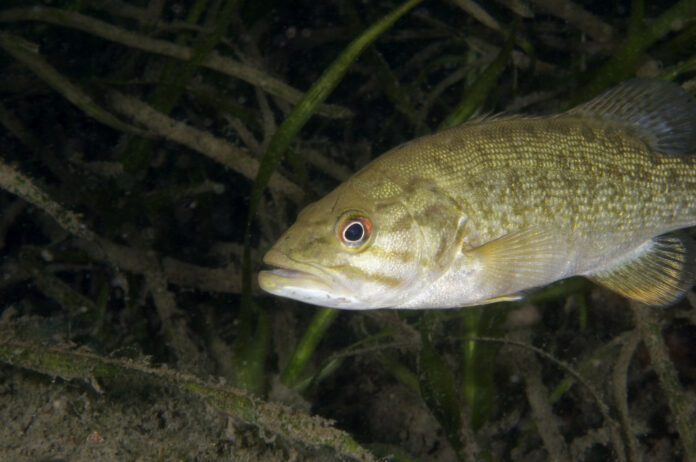The Bureau of Reclamation has proposed a new water plan to stop invasive fish in the Colorado River from wreaking havoc—but a conservation group has warned that it isn’t enough.
The humpback chub, which is native to the Colorado River and found nowhere else on Earth, is threatened by an invasion of smallmouth bass—a species that’s making its way into the humpback chub’s habitat.
The Colorado River runs through the Glen Canyon Dam, which forms Lake Powell, and eventually into the Grand Canyon.
The smallmouth bass live in Lake Powell, and until recently, they had nowhere else to go. However, lower water levels in the reservoir are allowing these fish to escape past the dam, and into the Colorado River.
LaSalle-Photo/Getty
Smallmouth bass are a warm-water predatory fish, native to eastern North America. They were put into Lake Powell in 1982 for recreational fishing purposes. But the invasive species has been affecting the Colorado River ecosystem for the past two decades, as they feast on other native fish species, drastically impacting the ecosystem.
The Bureau of Reclamation has now come up with an updated plan on how to help the humpback chub, as smallmouth bass continue to pose a threat.
However, conservation groups are not happy with the proposed plans.
“You’ve probably seen the announcement that the Bureau of Reclamation released a draft environmental impact statement on proposed changes to how it manages Glen Canyon Dam,” a statement from the Center for Biological Diversity, sent to Newsweek via email, reads. “The changes are intended to cool river flows in the Grand Canyon to prevent smallmouth bass reproduction, but the analysis doesn’t include dam screens to stop bass from passing through the dam in the first place. Unless stopped, the ongoing bass invasion will wipe out the Grand Canyon’s native humpback chub population.”
In its report, the Bureau of Reclamation suggests five ways to prevent the invasive fish from reproducing, including adding a “cool mix” to the Glen Canyon Dam. This proposal involves introducing cooler water into the water flows. As smallmouth bass are a warm-water fish, cooler waters could impact their spawning.
“Cool temperatures of less than 15.5 degrees Celsius (60 degrees Fahrenheit) year-round are expected to lead to minimal to no initiation of spawning in smallmouth bass and possibly other species, such as green sunfish, as well as poor growth and survival of early life stages,” the report explained.
They also suggest a “cool mix with flow spike alternative,” which would see a mix of water being released in order to maintain a daily average water temperature below 60 degrees Fahrenheit, “with the goal of disrupting smallmouth bass spawning.”
Another alternative is the “cold shock alternative.” In the report, this is detailed as releasing water for at least 48 hours through the river, “releasing the minimum amount of water required to create a cold shock all the way down to river mile 61 to disrupt smallmouth bass spawning and rearing.” Following this, it also suggests a cold shock with flow spike alternative.
The last suggestion, is the “non-bypass alternative.” This would consist of weekly flow spikes “using a combined action of lowering and then increasing the river stage within the range of the power plant’s capacity.”
“This analysis confirms that status-quo electricity production at Glen Canyon Dam will continue the inundation of predatory bass into the Colorado River, almost surely driving the Grand Canyon’s endangered humpback chub to extinction,” Taylor McKinnon of the Center for Biological Diversity said in a statement. “The agency needs to screen the dam to stop bass from entering the Grand Canyon in the first place, which it’s been promising but failing to do for eight years. Climate change is drying up the Colorado River, and deadpool at Glen Canyon Dam is inevitable. The Bureau of Reclamation must stop burying its head in the sand and develop a robust plan for navigating that in a way that protects the Grand Canyon’s endangered native fish.”
In recent years, the Southwestern U.S. has suffered from severe drought, which is leading to rapidly declining water levels in the Colorado River reservoirs.
In February 2023, Lake Powell’s water levels reached a historic low. Lake Powell’s neighbour, Lake Mead, is also under threat. As these reservoirs provide not just water, but electricity through hydropower, the Southwest is facing a very real water crisis.
Although the region has seen some storms recently, which should build up snowpack in the area, experts are concerned it isn’t a long time solution, and policy makers need to do more to ensure water is conserved.
Do you have a tip on a science story that Newsweek should be covering? Do you have a question about the Colorado River? Let us know via [email protected].
Uncommon Knowledge
Newsweek is committed to challenging conventional wisdom and finding connections in the search for common ground.
Newsweek is committed to challenging conventional wisdom and finding connections in the search for common ground.


